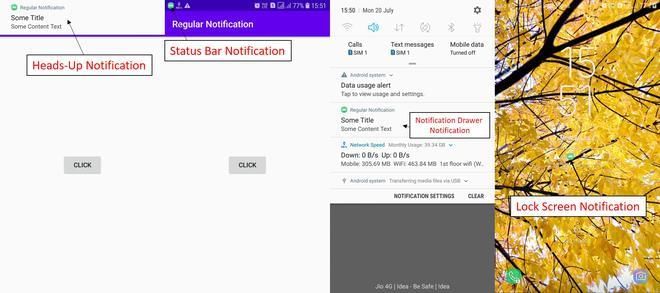Notifications in Android with Example - Software Development PDF Download
| Table of contents |

|
| Notifications in Android with Example |

|
| Creating Notification Channels in Android Studio |

|
| Key Concepts in Android Development |

|
| Output: |

|
| Please Login to comment... |

|
Notifications in Android with Example
Last Updated: 01 Jan, 2021Notification is a message, alert, or status of an application visible in Android's UI elements. It notifies the user about a process initiated in the application. Notifications serve as a crucial tool for developers to engage users and provide essential information.
Notification Types:- Status Bar Notification: Appears in the same layout as the current time, battery percentage.
- Notification Drawer Notification: Appears in the drop-down menu.
- Heads-Up Notification: Appears on the overlay screen, e.g., WhatsApp notifications, OTP messages.
- Lock-Screen Notification: Displays on the lock screen.

This article focuses on creating notifications in Kotlin.
KotlinStep by Step Implementation
Step 1: Create a New Project
To create a new project in Android Studio, ensure you select Kotlin as the programming language.
Step 2: Working with the activity_main.xml file
Open the activity_main.xml file and refer to the provided code. Design the layout page using RelativeLayout to access the ScrollView from the Kotlin file.
activity_main.xml- XML
Creating Notification Channels in Android Studio
Notification channels are essential for applications with Android API version 26 and above.
- Notification Channel Configuration:
- Applications with Android API version 26 and above require notification channels.
- Notification Channel Behavior:
- Each channel has specific behavior applicable to all notifications within it.
- Channel ID:
- Acts as a unique identifier for a particular channel.
Notification Builder in Android Studio
The notification builder is crucial for generating notifications in Android Studio.
- Functionality of Notification Builder:
- Provides a convenient way to set various fields of a notification.
- Content Views:
- Generates content views using the platform's notification layout template.
- Notification Channel Targeting:
- Notification builder does not target a specific notification channel.
It is crucial to understand the differences and requirements between notification channels and the notification builder in Android Studio to effectively implement notifications in your applications.
Creating a New Activity in Android Studio
Follow these steps to create a new activity in Android Studio:
- Step 1: Open Android Studio and create a new empty activity.
- Step 2: Name the activity as "afterNotification".
- Step 3: Customize the layout of the new activity.
Key Concepts in Android Development
- Dependency Implementation
It's often suggested to implement the dependency "com.android.support:support-compat:28.0.0" in Android development. However, in practice, it might not always be necessary for the smooth functioning of your application.
- Working with MainActivity.kt File
When working with the MainActivity.kt file in Android development, it is crucial to understand the code structure and various components involved.
- Notification Management
Notifications play a vital role in keeping the user informed about events in the background. It involves creating notifications and handling user interactions.
- Notification Customization
Customizing notifications allows developers to tailor the content, icons, and behavior of notifications according to the app's requirements.
- Notification Management
- Creating Notifications
Creating notifications in an Android application involves setting up channels, defining notification content, and handling user interactions effectively.

Output:
- Video Player
- 00:00
- 00:14
- Use Up/Down Arrow keys to increase or decrease volume.
Please Login to comment...
- Login
- Like


















